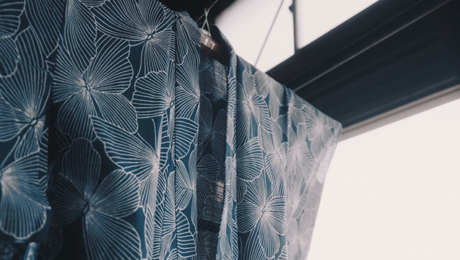
Breathing new life into yukatas with classic patterns using colors and materials.
2022.06.22
FASHIONClassic yukatas used to be white cloth dyed indigo or navy blue. Over time, the color patterns have grown in variety and other than summer events, it is now common to wear them out in everyday life and in various other situations as well. Since its establishment in the Meiji period, Marukyu Shouten has been a wholesaler that mainly offers yukatas and cloths that become part of people’s everyday lives. It focuses on products made with a uniquely Japanese stencil dyeing technique called “chusen” and in recent years, it has been proactively creating products that convey the many charms of chusen such as the restoration of old designs and devising new patterns.
“Every year, we release about 30 yukata patterns. Generally, we do not create classic pieces but deliver fabrics incorporating the needs of the period,” says the fifth generation owner Ms. Misako Saito. One of this year’s new creations is a cotton-linen fabric with a pattern called “horizontal peonies.” Usually, 100% cotton fabric is often used, but taking into account the recent popularity of linen, this is its third year creating a series that makes use of “Shinnosuke-Joufu” weaved by artisans from Shiga.
“It is a fabric that is very comfortable to wear as it is soft to the touch and has the suppleness of linen. It is 55% linen and in the chosen process, it shrinks easily and is difficult to handle, but this year, we had chusen maker Mr. Takashi Sekizawa meticulously create a beautifully delicate peony pattern.”
It is available in three colors, ink, silver, and peacock. Each one is a chic color and coupled with the supple texture of the fabric, one can enjoy pulling off the look of a mature lady even when it is not midsummer. In recent years, Japan’s climate has been getting hotter due to global warming and apparently, there have been more requests saying that they would like to make use of yukatas from mid-May to early September. This time, many of the new creations are subdued fabrics that are also appropriate as kimonos without giving the impression of being a yukata.


The “roketsu yukata”, which is apparently being released for the first time in several years, has a delicate and profound expression brought about by the cracks of the wax used for resisting dye. “May umbrella”, which was inspired by the style of the artist Settai Komura, is a fabric created by dyeing an umbrella chain pattern and striped pattern twice to exude the essence of Edo.
“When people tell me that they can enjoy the classic patterns as stylish yukatas, that makes me happier than anything. I hope to continue to propose various “forms of clothing”, including yukatas, so that more people will know about the charms of chusen.”







